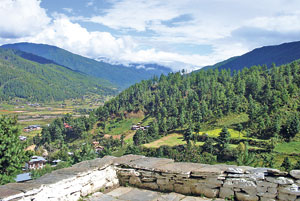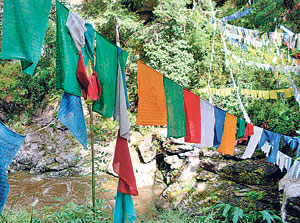Magical, mystical are the phrases that emanate to describe the Himalayan Kingdom of Bhutan. Wedged in between India and China, this landlocked young democracy, the size of Switzerland and with a population of just under 700,000 is one of the ten biodiversity hot spots to visit. In fact, due to its popularity, the Government plans to restrict the entry of tourists and thus has a cap of a minimum of US $ 200/- per day, which may be increased next year to US $ 250/-. Bhutan is known as the Land of the Thunder Dragon, in fact the Bhutanese do not climb their mountains as they believe the Gods reside there.
It had always been a dream of mine, since I had heard the legends of Padamasbhava (the second Buddha – Sakyamuni) to visit Bhutan. Guru Rinpoche as he is also known had miraculous powers. The Guru rode across from India on a tiger and landed in the Kingdom to assist the ruler with a demon whom he finally converted. I also had conjured up visions of Bhutan as similar from the book and film Lost Horizon by James Hilton, and I was not disappointed.
 |
| The Gantry valley- famous haunt of the Tibetan Black Cranes and left, prayer flags dot the landscape |
 |
The former King and his son the present King have guided the country into a democracy where the Royal family voluntarily relinquished their monarchical role to a more ceremonial role, so that the people of the country could aspire to govern as well. The Monarch retires at 65.
Elections were held in 2008 where the present King Jigme Khesar Namgyal Wangchuck succeeded his father to the Raven Throne. The Royal family are low key and are involved in the welfare of their people and greatly loved. The simplicity in the way they live and their behaviour is exemplary. There was much debate as to whether the monks should be given the vote and this was decided against. The Chief Monk is on par with the king.
Each province has a dzong or fortress, which houses the administration and the monastery/temple and is a striking aspect of this country. These dzongs are constructed without any plans and the architect relies on a mental concept.
The Bhutanese proudly state that not a nail is utilised. At the entrance to all the dzongs one sees the paintings of the four guardian gods or kings of the four directions, who guard the world against demons and earthly threats. Each king according to Mongolian tradition holds a different object.
The Bhutanese wear their national costume when visiting a dzong or whilst on official duty and as a mark of respect the men wear a ceremonial shawl and the women a sash. The men wear a gho, a long robe which is hoisted to knee length and tied with a woven cloth belt called a kera and a large pouch formed above it to carry one’s wallet, etc. Formerly, embroidered leather boots were worn, but these are now worn on special occasions. Red and yellow are colours retained for the monks. The women wear a floor length dress called a kira worn over a blouse.
The kira is fastened at the shoulders with elaborate silver hooks and at the waist with a belt that is of either silver or cloth. Over the top is worn a short, open jacket like garment called a toego. Every Dzong (monastic fortress) conducts a traditional festival for three days on the 10th day of the month according to the lunar calendar. Here the monks perform traditional dances. On the last day a huge flag of Padmasambhava is unfurled which is purported to bless those who have attended the tsechu. Bhutan is the bastion of Vajaryana Buddhism, a spiritual practice that is known to be one of the most profound schools of teachings in the Buddhist world.
The country is dotted with monasteries with legends; prayer flags flutter at mountain passes, ridges and near holy shrines and I was told that an astrologer is consulted as to where these flags should be hung and on what day the poles should be erected. The prayers are blockprinted on to flags in five colours –blue, green, red, yellow and white. I was privileged to see and hear the monks reciting the age old prayers from their manuscripts, whilst beating a drum to keep in rhythm, and interspaced with flutes and huge horns being blown. At most of the monasteries that we visited, there was always a monk reciting prayers and one felt that here was a land that lived with and by its religion. In fact, there was a serenity that pervaded the country.
The main goal in life is happiness and in fact there is GNH Secretariat to ensure that this is achieved. The main benchmarks of their development are:
Self reliance
Good governance
The environment
Sustainable development
Culture
The King in fact visits remote villages to find out what the villagers require to make their lives happy. The philosophy of this country is based on GNH and not only on Gross National Product One of the Queen Mothers has in fact written an account of her travels to the remote regions of this kingdom to find out what the people required and began a foundation, which supports some of the recipients.
Seventy two percent of the country is under forest cover and no trees can be felled without a valid permit. Living in balance with nature and spiritualism is their key and what we have certainly lost.
Tourism is one of their principal forms of revenue,but this is monitored and carefully controlled where the tourist entering is from the high-end market. The other forms of revenue are hydro-power, agriculture and timber.
One of the most famous monasteries Tiger’s Nest or Taktshang Goemba is situated on a cliff 900 metres above the Paro valley where the famous Padmasambhava flew on the back of a tiger, his female consort. There are mules which one can hire that take the pilgrim halfway to a little above the cafeteria or if you prefer to climb, a stick is helpful.
As you walk uphill one pauses to see the stunning vista of hills in the distance, the clouds above and a clear blue sky. The sounds of a nearby waterfall and a few birds chirping are the only sounds emanating as you walk up to the holy shrines where the Master meditated for three months. I paused a while in the main cave to listen to the lone monk chanting, keeping time with his drum, whilst the pilgrims came and paid their respects to the Guru.
A fable that one sees repeatedly painted at temples, homes and shops which is one of Bhutan’s favourites relates to teamwork. The story relates how the elephant, monkey, bird and rabbit jointly worked together to obtain a continual supply of fruit. The bird found and planted a seed, the rabbit nurtured it, the monkey fertilised it and the elephant guarded the plant. When the fruit was ripe and the tree was too high for the smaller animals to reach, the four animals formed a tower by climbing on each other’s backs and plucked the fruit.
Flying back on Druk Air over the snow capped mountains of the Himalayan range, the mountains looked like white frosting on a gigantic cake. I silently willed myself to return to a country, which is unspoilt and on the right path. |



